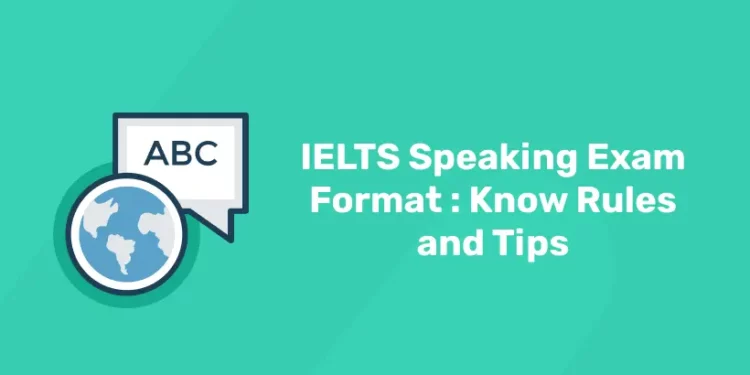Table of Contents
Even though you may be anxious about your IELTS Speaking exam, you can boost your confidence and achieve the necessary IELTS band score with plenty of practice and these ten suggestions from our IELTS experts. The face-to-face Speaking test for the IELTS computer and paper versions consists of three sections. You will be more prepared if you know what to expect from each of these three Speaking test sections. In this article, we cover the IELTS Speaking Exam Format and the best tips for how successfully complete IELTS Speaking.
Crack the IELTS Exam With Online Coaching – Enrol Now!
Introduction
The Speaking exam involves the test taker and the examiner having a face-to-face interview. It establishes the candidate’s speaking proficiency. Each speaking exam is recorded for future use in case the examination has to be reassessed or remarked upon. You can practice IELTS Speaking themes to get acquainted with the format of the test. You can also record your responses and play them back to evaluate your performance and grasp the speaking requirements.
The contestants will talk for one to two minutes on a predetermined topic in Part 2. They’ll also have a minute to get ready for this section. Part 2’s subject offers the basis for a further discussion in Part 3. On average, the test takes 11–14 minutes to complete. Let’s examine each of the three sections in more depth.
What is the Pattern for IELTS Speaking Test
1: Most university students ........................ on campus in their first year.
A professional and trained examiner interviews the test taker in order to administer the IELTS Speaking exam. The test takes 11–14 minutes to complete in total. Part 1 lasts four to five minutes, Part 2 is three to four minutes, and Part 3 takes the candidate four to five minutes.
There are three sections to the IELTS Speaking test structure, and each calls for a distinct approach. The first segment serves as a warm-up and includes questions on two topics, an ID check, and some introductory questions. These often focus on the candidate’s biography and journey.
Part 1: Introduction and interview. (4–5 minutes)
- The examiner will ask questions about the test-takers background details, field of interests, hobbies and experiences.
Part 2: Individual long turn. (3–4 minutes)
- A task card containing a topic and one minute to prepare is given to test participants. They then discuss the assigned subject for one to two minutes.
Part 3: Two-way discussion. (4–5 minutes)
- The test-taker and the examiner have a conversation about the subject covered in Part 2. This stage evaluates the candidate’s capacity for idea expression, abstract concept discussion, and strong argument construction.
Ace Your IELTS Exam with Confidence!
Unlock your potential with our expert-led IELTS preparation course. Achieve your dream score and open doors to global opportunities!
Start Your IELTS Journey Today!What is the Format of IELTS Speaking Test
The IELTS speaking exam is the same for all test takers. This suggests that the formats for the IELTS Academic Speaking and General Speaking tests stay the same. The framework of the IELTS Speaking test is simple to comprehend, and it will evaluate you according to the following criteria:
- Your ability to communicate in English fluently and without hesitation or pauses throughout a discussion.
- Among other things, it will examine your usage of conjunctions, pronouns, and connectors.
- The examiner should be able to grasp the language and accent.
- Together with sentence structure and grammar, the examiner will evaluate your vocabulary.
- The examiner will assess intonation and pronunciation as well.
Part 1: Introduction and Interview
Format:
- The examiner verifies your identity and makes an introduction.
- Some basic personal information is requested from you, including your name, nationality, and place of origin.
- General inquiries concerning the candidates hometown, occupation, hobbies, family, and educational background will be made of them by the examiner.
- Initially, applicants will need to provide their name, passport or ID, and the name they would like the examiner to use to address them.
- The ability of the candidate to express opinions and ideas regarding common experiences and everyday features is assessed in this section.
Duration: The first section of the exam should take four to five minutes.
Part 2: Individual Long Turn
Format:
- In this section, They will give you a Cue Card ,Also known as the Task Card
- You have one minute to prepare your response on the specified subject.
- You have one or two minutes to speak about this subject.
- This section will evaluate your ability to speak intelligently about any subject.
- If you haven’t spent the full two minutes, you might be asked one more question.
Time Duration: On average, three to four minutes are spent on this section.
Part 3: Discussion
Format:
- You will be questioned by the examiner on the previously mentioned subject.
- It will be necessary for you to provide more in-depth and subjective opinions.
- This portion assesses your ability to analyse a subject, present and defend your opinions, and arrange your thoughts.
- You will be required to respond in greater detail to four to five questions.
- There may be moments when the examiner interrupts you; try not to become upset if this occurs.
- Most questions address many facets of your life. Still, they might address more general concepts and issues.
Time duration: The average duration of Part 3 is four to five minutes.
Crack IELTS Exam With Online Coaching – Enrol Now!
What are the Best Tips for IELTS Speaking
Since this portion of the IELTS Speaking test requires face-to-face conversation, many applicants believe it to be the most difficult. The simplest part of the IELTS to score higher on is, in reality, the Speaking section. However, you can also raise your score by utilising these straightforward IELTS Speaking strategies. The top ten IELTS speaking strategies are provided here to help you improve your score:
1. Don’t memorise answers
Particularly for Part 1, avoid memorization of answers. The examiner cannot determine your level of proficiency in the English language from memorization. Your final band score may be affected if the examiner detects that you have memorised your answers.
2. Avoid using complicated and unfamiliar words
In your Speaking test, you might try to use large, difficult vocabulary to wow the examiner. However, don’t use unfamiliar terminology just to be cautious. The likelihood of errors increasing is increased when terms are mispronounced or used incorrectly. Your final band score may suffer from errors.
Make use of a vocabulary that is relevant to the subject at hand and spans your knowledge base. To assist you learn new terms and phrases related to the themes covered in Tip 10, look over the topics and create mind maps or vocabulary lists.
3. Make use of various grammatical constructions.
Examiners for the IELTS evaluate your speaking abilities based on the following standards:
- Fluency and coherence
- Lexical resource
- Grammatical range and accuracy
- Pronunciation
To convey your ideas, try utilising a variety of grammatical constructions in both complicated and basic sentences. Recognise your own mistakes and work on chatting to friends in English. You can even videotape yourself to check for mistakes. If you catch someone making a mistake, make sure to fix it. Practise speaking in the past, present, and future tenses correctly because your assessment will focus on your ability to employ various grammatical constructions correctly.
4. Be at ease with your accent.
Using an in-person In contrast to an AI system, the IELTS examiner can comprehend a wide variety of accents throughout the speaking examination. There is no need to worry if you are a good communicator. But since English is a stress-timed language, be mindful of the consonants you find problematic and apply intonation and emphasis appropriately. If you practise with friends, they will let you know if they don’t understand you.
5. Pause to think
It doesn’t hurt to wait for a moment to gather your thoughts before speaking. It is what we all do to answer inquiries. During the Speaking test, you can utilise the following sentences to buy yourself some extra time to think:
- That is a thought-provoking query.
- It is something I have never considered, but…
- Let me observe
- That’s a valid point.
- Though it’s a challenging question, I’ll do my best to respond.
- Yes, some individuals claim that to be the case, but in my opinion…
- Let me consider that for a moment.
6. Avoid using fillers
Don’t use filler words and speak with assurance. We often resort to fillers when we are at a loss for words, but this communicates to the examiner that you are unable to obtain the right words or concepts, therefore it’s crucial to stay away from them and make use of the expressions we provided in Tip 5.
Avoid the following fillers:
- Like
- You know
- Umm…
- Ahh…
- Ehh..
- Well
- Yeah…
7. Expand on your responses.
Do your best to respond to all of the examiner’s queries. Don’t wait for the examiner to ask you a question; instead, take your time answering. Short responses indicate to the examiner that you are unable to discuss a subject in depth. When the examiner asks “Why?” you are being prompted to elaborate and provide a rationale for your response.
8. Smiling helps pronunciation
You can improve your pronunciation by reducing your anxiety by smiling. Make sure you open your mouth wide enough to allow sounds to be heard properly as you enunciate. Our mouths get wider and our voices become friendlier when we smile. You can demonstrate to the examiner that you can use a variety of pronunciation qualities by using clear enunciation and tone.
9. Avoid speaking in monotone.
There are moments when our speech sounds monotone, flat, and unvarying. This makes it harder to communicate what you say and harder for the audience to understand which points in your speech are crucial. Making targeted word choices and pauses during speech segments are effective strategies to enhance the interest level of your exchange with the IELTS examiner. It is simpler to compare and contrast concepts when we highlight important terms. It also improves the conversation’s flow, so keep this in mind:
- Avoid speaking in monotone.
- To enhance emphasis, change the intonation and stress.
- Make gestures with your hands to contribute to the conversation’s pace.
10. Practice common IELTS subject areas.
You get two minutes to talk on a particular topic in Part 2 of the IELTS Speaking test. With friends, family, or co-workers, practise frequent IELTS themes to get better and pick up vocabulary related to each topic.
You can practise the following common themes for the Speaking exam:
- Travel and tourism
- Education
- Transportation Environment
- Sports and leisure activities Family life
- Crime and penalty
- Online retail and advertising
Related : Tips to use storytelling in the IELTS Speaking Test
Entri App- Online IELTS Coaching
Since it provides a comprehensive study package that will enable you to receive a high band score, Entri App’s IELTS course is exceptional. In addition to more than 100 study materials, sample notes, live, one-on-one, and group interactive sessions with our professional mentor, recorded sessions, weekly assessments, and remote learning options, our course provides IELTS applicants with a unique and affordable learning experience.
Courses Offered
Take our academic version of the IELTS if you want to study overseas. Alternatively, our general IELTS course is ideal if you’re looking for a job or permanent residence.
- General IELTS
- Academic IELTS
Course Overview
- 30 Days Mentorship
- Exam Packs – Reading Practice
- PDF Course materials
- 6 Months Recorded Videos Validity
- Live Exams and Special Exams
- Recorded Video Classes on App
- Guidance & Recorded Videos for IELTS: Receive Mentorship
Ace Your IELTS Exam with Confidence!
Unlock your potential with our expert-led IELTS preparation course. Achieve your dream score and open doors to global opportunities!
Start Your IELTS Journey Today!Frequently Asked Questions
What is the format of IELTS Speaking test?
A professional and trained examiner interviews the test taker in order to administer the IELTS Speaking exam. The test takes 11–14 minutes to complete in total.
Is IELTS Speaking strict?
Most IELTS test takers, particularly those who don’t regularly use English, think that the speaking portion of the test is challenging.
Is it easy to pass IELTS Speaking?
Another aspect of the IELTS that is thought to be challenging is the speaking portion. This is due to the fact that students must be able to articulate their thoughts and opinions clearly.
What are the 3 parts of IELTS Speaking test?
- Part 1: Introduction and questions on familiar topics. 4 to 5 minutes.
- Part 2: Individual long turn. 3 to 4 minutes.
- Part 3: Two-way discussion. 4 to 5 minutes.









